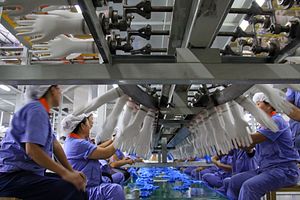China is attempting to restructure its economy, reorienting the manufacturing sector toward the production of more technology-intensive goods and expanding the service sector in order to move up the economic ladder from a middle-income country to a high-income country. Premier Li Keqiang stated in his Work Report at the National People’s Congress in March that China needs to rebalance away from investment and trade and toward domestic consumption and service industries. This is in line with the Fisher-Clark theory of structural change and a very common view that as economies modernize, they must shift from a focus on primary industry (agriculture), to secondary industry (manufacturing), to tertiary industry (services). Yet could moving up the value chain be a mistake for China?
Contrary to common belief that to move up the economic ladder a nation must transition out of a focus on manufacturing to a stronger emphasis on services, we proffer the cases of the United States and Japan. The U.S. and Japan have service sectors that contribute close to 70 percent of GDP and manufacturing sectors that represent about 20 percent. Manufacturing has moved abroad to places like China and Vietnam, where labor has been far cheaper, while the services sectors in these countries have become increasingly sophisticated and skill-intensive. Both the U.S. and Japan are now mourning the loss of manufacturing jobs overseas, as sources of economic growth have diminished and economic inequality has widened.
A major argument in favor of moving up the structural ladder is that increasing economic productivity should be reflected in increased modernization of sectors away from labor-intensive processes and toward more technology-infused or skill-intensive processes. This should be accompanied by a heavy policy emphasis on educating the work force, so that individuals can continue to find employment in a more mentally demanding work environment. Increased productivity will lead to a shifting out of the production possibilities frontier and sustained economic growth.
The corollary to this argument is that as an economy shifts up the value chain, less skill-intensive, more labor-intensive jobs are lost. For developed economies like the U.S. and Japan, this has been a painful process for the less skilled component of the workforce and has in reality reduced employment for some, and most likely GDP for the economy as a whole, contradicting the notion that this structural change boosts the economy all around. In light of this, the idea that China, the world’s most populous nation, should move away from unskilled labor intensive jobs is of great concern.
Granted, the economy would do well to enhance its technology intensive manufacturing sector and its service sector, but not at the expense of its less-skilled manufacturing sector. A reduced policy focus on the export sector, coupled with rising wages, has already led to diminished low-skilled manufacturing production in China. There is still, however, a relatively large percentage of workers who need lower-skilled employment in order to make a living.
Some analysts may point out that there has been a dearth of young workers for these manufacturing jobs since 2004 due to changing demographics. Despite this fact, as it stands, workers over 40 face severe job discrimination in obtaining manufacturing jobs and often face declining salaries as a result. They want the jobs. If this discrimination issue can be overcome, these workers could find suitable manufacturing employment and maintain their standards of living. Low-skilled manufacturing jobs may also provide a good source of employment for residents who have been moved from rural to urban areas during the urbanization process, who have just moved out of the agricultural sector.
Perhaps a shared emphasis on the manufacturing and services sectors would result in more of an economic balance than the 20 percent/70 percent distribution evident in the U.S. and Japan. In China, the ratio of contribution to GDP is currently about 30 percent for manufacturing and 40 percent for services. Enhancing both sectors while preserving some low-skilled manufacturing jobs will help to maintain a structural balance more conducive to long-term growth and employment for the world’s largest population.
Among the myriad tasks that the current leadership has committed to undertake, we hope that China’s strong performance as the world’s center of production will not become a distant memory as an economic ideal is chased. If that occurs, future leaders may have to strive to introduce low skilled jobs further down the line, likely at a higher cost.
Follow Sara Hsu on Twitter @SaraHsuChina.

































